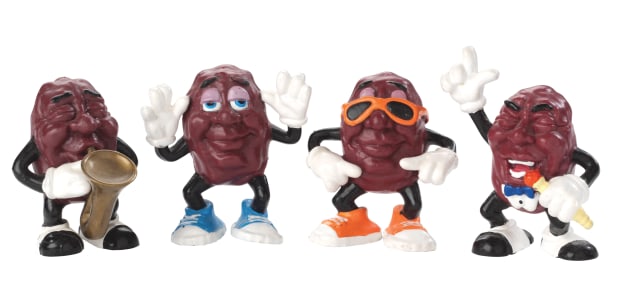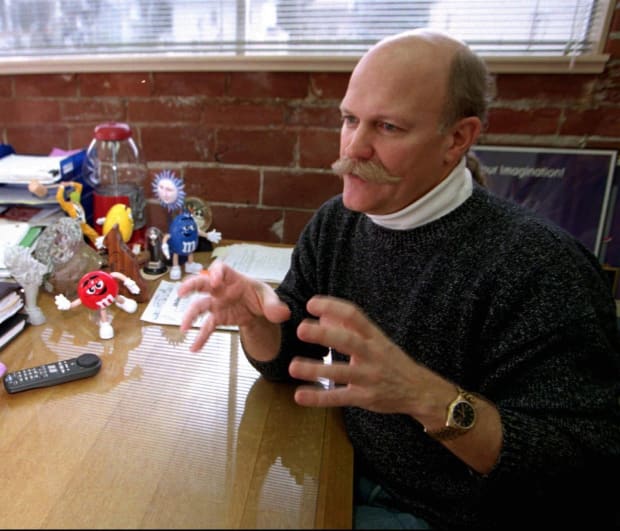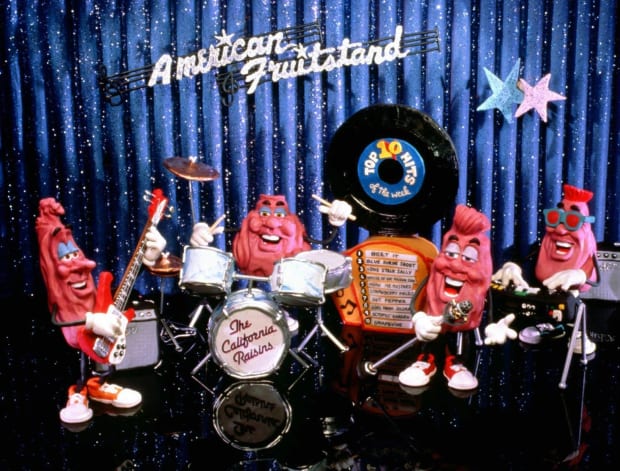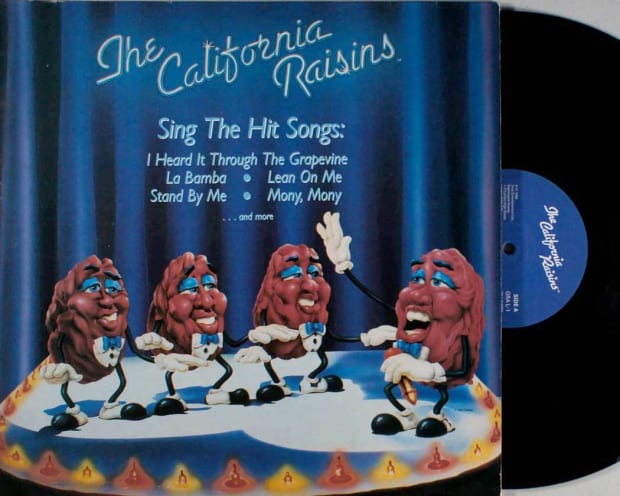The singing, dancing, anthropomorphized raisins began with a 1986 TV ad and turned into a cultural phenomena as the coolest wrinkled musicians this side of the Rolling Stones.

A group of singing, dancing, anthropomorphized raisins launched a sensational career after singing the 1968 Marvin Gaye song, “I Heard It Through the Grapevine,” in a 1986 commercial for the California Raisin Advisory Board.
This was also the first time in history that a commercial spawned such a volume of merchandise, and in 1987, the California Raisins’ popularity exploded after Hardee’s created molded Raisins figurines to promote its cinnamon-raisin biscuits. Combined with more TV ads, and even a music album, The California Raisins Sing the Hit Songs, the Raisins’ images were everywhere, and a cultural phenomenon was born.
More TV ads, albums, and merchandise ranging from lunch boxes to clothing followed. They also eventually starred in an Emmy-nominated TV special, 1988’s Meet the Raisins, and their own Saturday-morning cartoon on CBS, from 1989-90.
Not bad for little wrinkled pieces of fruit.

The raisins were the brainchild of Will Vinton, an Academy Award-winning filmmaker who coined the term Claymation to describe the three-dimensional animated clay figures he used in his work, including the wildly popular California Raisins advertising campaign of the 1980s.
While studying architecture at the University of California at Berkeley, Vinton, who died in 2018 at the age of 70, often used modeling clay in his designs. After college, he worked in advertising, then moved to Portland and started experimenting with clay animation in his basement.
The painstaking style requires hundreds of changes in the clay figures — which are photographed and spliced together — to create an animated “stop-motion” film. Perhaps the best known early example is Gumby, a stop-motion clay figure that debuted in the 1950s.
“Clay is a natural material for animation,” Vinton said in 1992. “Clay characters can show a wide range of emotions, and they’re able to transform easily from one shape to another.”
An advertising agency came up with the idea of having animated raisins dance to a version of the Motown hit “I Heard It Through the Grapevine” and hired Vinton to create the commercials. He and the artists in his studio designed more than 25 clay raisins — no two looked exactly alike — and spent months animating the first commercial, which aired in 1986. The raisins marched out of a box, singing and dancing in unison along a tabletop like a miniaturized soul group from the ’60s. Other snack foods fainted and collapsed, unable to match the raisins’ slick moves and sense of cool.
Vinton created a series of commercials featuring the California Raisins. The figures, about eight inches high, were sculpted over a wire frame. A 30-second commercial contained 24 frames per second, which meant that 720 individual scenes had to be meticulously set up by hand. Each commercial took about five weeks to complete.
The work paid off for California’s raisin growers, who saw their sales increase by 20 percent. Various brand-name cereals climbed on the bandwagon with Claymation commercials of their own, and the California Raisins became a certified cultural sensation.

Several music stars, including Ray Charles and Michael Jackson, lent their images to California Raisins commercials, some of which were shown only in movie theaters.
“Michael called up and I’m sitting there, having small talk with Michael on the phone,” Vinton told the Pittsburgh Post-Gazette in 2009. “And I’m going, ‘What is this about? Why am I having this conversation?’ I realized he was talking about the California Raisins.
“I said, ‘Michael, we should make you a raisin!’ I realized he was heading that way, anyway. And as soon as I said it, he said, ‘Yeah!’”
In March of 1997 Entertainment Weekly published “The 50 Best Commercials of All Time” as its cover story. The California Raisins’ debut advertisement, “Lunchbox”, was ranked number 15 on the list. Ad agency executive Claude Jacques described the Raisins as “The coolest wrinkled musicians this side of the [Rolling] Stones.”

A slew of merchandise centered around the California Raisins became popular with collectors and a robust secondary market grew for collectibles. But like all fads, interest chilled and values dropped dramatically. There is still plenty of California Raisin items found on eBay, for example, but for the most part the raisin craze remains valuable largely as a memory rather than as a collectible.
“A good character is something great to behold,” Vinton told The Washington Post in 1999. “The proof ultimately is how cool it is, whether there’s buzz around the water cooler.”
For a long stretch that buzz made even raisins seem cool.
You May Also Like:
1980’s Rubik’s Cube Made it Hip To Be Square
Trivial Pursuit Answered Our Need to Know









